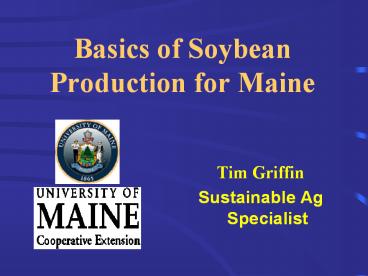Basics of Soybean Production for Maine - PowerPoint PPT Presentation
1 / 36
Title:
Basics of Soybean Production for Maine
Description:
Weed control. Harvest and processing. Soybean Maturity Classes. 13 maturity classes ... Faster ground cover helps weed control ... – PowerPoint PPT presentation
Number of Views:120
Avg rating:3.0/5.0
Title: Basics of Soybean Production for Maine
1
Basics of Soybean Production for Maine
- Tim Griffin
- Sustainable Ag Specialist
2
(No Transcript)
3
Factors Driving Interest
- Local protein source for animals
- Human consumption (export)
- Alternative potato rotation crop
- Replacing small grains?
- Lengthening rotations?
- Moderate profit potential
- New, short-season varieties
4
General Information
- Annual legume that fixes N
- Poor tolerance of acid soils
- Recently developed varieties can reach maturity
in Northeast - Little things make big difference
"Management Points"
5
Management Points
- Variety selection
- Site Selection
- Soil drainage
- Soil pH
- Fertility
- Seeding practices
- Weed control
- Harvest and processing
6
Soybean Maturity Classes
- 13 maturity classes
- 000, 00, 0, and 1-10 (10 is longest)
- 000 - 1 adapted to Maine
- To start, pick the shortest season varieties
- 000 and 00 in Aroostook County
- 0 to 1 in central/southern Maine
7
Soybean Yields 1997
- Variety Maturity Orono Presque Isle
- ---------- bu/acre ---------
- Aquilon 00 35 31
- APK007 0.7 40 33
- APK020 0 34 33
- Bravor 0.5 30 25
- Korada 0.2 41 22
- Lambert 0.8 35 36
- Pioneer 9007 00 36 30
- Pioneer 9071 0 44 33
- Pioneer 9092 0 42 33
- Pioneer 9132 1 41 34
- Stine 380 1 45 31
- Ugo ----- 34
8
Soybean Yields 1998
Variety Maturity Orono Presque
Isle --------- bu/acre ----------- Alta
00 26 23 Aquilon 00 43 25 APK020
0.2 61 28 Korada
0.2 35 21 Optimus 00.5 40 24 Pioneer
9007 00 42 26 Pioneer 9041
0 57 21 Pioneer 9071 0 52 21 Pioneer
9132 0 59 29 Pioneer 9163
1 64 22 PR9755 00.9 56 25 Yamaska
00.8 46 21 Vision 000 29 ---
9
Mature Beans
10
Maturing Beans
11
Soil Factors Drainage
- On poorly drained soils
- Reduced N fixation
- Increased disease potential
- Delayed planting
- Harvest problems
- On sandy - gravelly soils
- Drought stress during pod fill a problem
- Find well drained sites
12
Soil Factors pH
- Recommended range 6.5-7.0
- Could grow down to 6.0-6.2
- On acid soils
- Reduced N fixation from Al toxicity
- Reduced nutrient availability
- Soybean, like most legumes, are quite sensitive
to low pH
13
pH Affect on Yield
14
Soil Factors Fertility
- Moderate nutrient removal
- 40 lb P2O5/a
- 80 lb K2O/a
- Even though nutrient use is moderate, still
responds to P and K on low soil-test sites - Poor performance on low fertility fields
15
Planting Spacing
- Can be planted several ways
- Wide rows 30-36 inches
- Narrow rows 5-15 inches
- Narrow rows
- Faster ground cover helps weed control
- Can use grain drill or air planter (need
different plates with corn planter)
16
Planting Spacing
17
Planting Rate
- Rate depends on spacing
- Narrow row 200 - 225,000/a
- Wide row 150 - 175,000/a
- Significant differences in seed size
- Plant by number, not weight
18
Planting Dates
- Yield reduction with delayed planting, but not as
severe as with corn - In our short season, timely planting is important
to reach maturity, but - Plant into warm soil in right conditions - Beans
dont tolerate crusting or compaction
19
Early June Planting -Worked
20
May Planting - Didnt Work
21
Planting Doing it Right
- Know seed delivery rate
- Inoculate with Rhizobia
- Slightly dampen seed
- First time beans - triple inoculant rate
- Well-prepared seedbed critical
- Assure good seed-to-soil contact
- Control planting depth
22
Planting Doing It Right
- Plant 1 - 1.5 inches deep
- Pack after planting
- Press wheels on planter
- Cultipacker
- Easier harvest operation
23
A Good Seeding
24
Weed Control
- Early tillage possible
- Timed at weed emergence
- Lely-type cultivator
- Rotary hoe
25
Plant Competition
- Slow early growth
- Planted May 14, Picture June 15
26
Soybean Grass Herbicides
- PreEmergence
- Dual, Dual II, and Dual II - Magnum
- Frontier, Harness, Microtech, Lasso
- Combinations (BSD)
- PostEmergence
- Poast, Poast plus, Assure II
- non-selective Liberty, Touchdown, Roundup
27
Soybean Broadleaf Herbicides
- PreEmergence
- Lorox, Sencor/Lexone, Prowl
- Python (Broadstrike)
- PostEmergence
- Banvel, Clarity, Basagran,
- Pursuit, Classic, Select, Reflex
- Pinnacle, Python, Resource
28
Broadstrike Dual - Dry Conditions
29
Harvest
- Pods 2-4 from soil
- low populations have lower pods
- Remember packing after planting?
- Losses in front of combine
- Average harvest loss in 1997 was 11 bu/acre
- Stored soybeans at 14 or less
30
Anti-Quality Factors
- Urease enzyme (urea to ammonia)
- Lipase enzyme (rancidity)
- Trypsin inhibitor
- High soluble N content
31
Feeding Raw Soybeans
- Limit grinding to 1 week supply
- No urea in ration
- Limit to 3-4 lb/head/day
- Ration balancing can be difficult because of
soluble N and anti-quality factors
32
Roasting Temperature
33
Roasting Time (140C)
34
Roasting
- Increase feeding level 8 lb/hd/day
- Economics
- Cost 30-40/ton
- Increased price by 70-100/ton
- Difference added value by roasting
- Optimum temp 275-300F
- Steeping increases uniformity
- Storable if not ground
35
Results of Roasting
- Reduces urease and lipase
- Reduces trypsin inhibitor
- Increases bypass protein
- Fat level not affected
36
Management Points
- Site Selection
- Soil drainage
- Soil pH
- Variety selection
- Fertility and pH
- Seeding practices
- Harvest and processing































